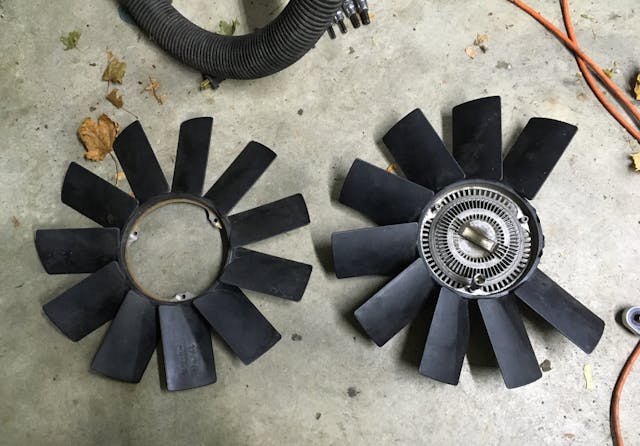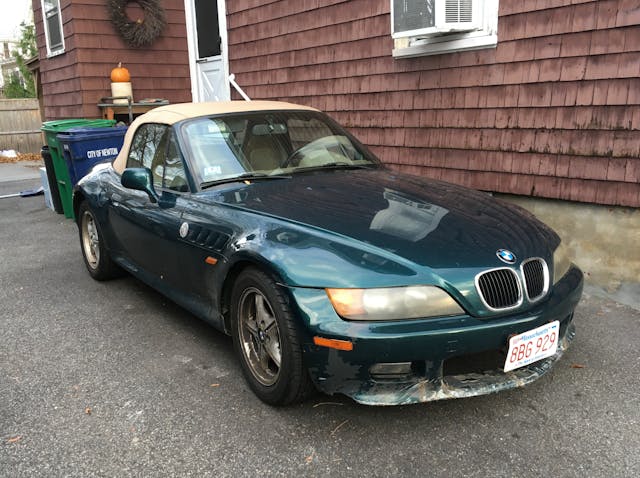Media | Articles
The Resurrection of Zelda, Part 2: Finishing a curb override on a budget

Last week, I described how Zelda, my former car—a slightly ratty but fully functional 1999 BMW Z3 2.3, the center of “The Cult of Zelda” (women friends who borrowed it for stress-busting drives), and now owned by my dear friend and neighbor Kim—suffered a curb strike when her son drove it over a median strip in a careless moment. The right front wheel had been mashed backward into the fender well, the airbag had gone off, the front air dam was splintered, and all four wheels were bent.
Further collateral damage included the broken A/C compressor bracket, bent condenser, and partially destroyed electric fan, the missing plastic fender liners, and a variety of pulled or sheared electrical connectors. It was damage that clearly would’ve caused the insurance company to total the car. However, miraculously, no sheet metal had been bent. At least that was what I thought. And it was almost true; I later found that the tire had caught the corner of the right front fender when it got mashed under. While this was trivial, the pushed-back front wheel was not.

Although I don’t own the car anymore, it and its owner exist within my karmic orbit, so there was no question that I’d help Kim out. She offered to sell me the car for a fire-sale price, but even before the accident, it badly needed a clutch (it was chattering and the thowout bearing was screeching), so both the left-brain upside calculation and the right-brain “do I want to spend time doing this” calculation weren’t yielding slam-dunk “buy the car back” results. I limped the poor damaged thing back to my house to attempt to make it drivable, which bought Kim and I options and increased the car’s value should its fate be to go to someone who would make it whole.
Now, I’m a mechanic—I don’t do bodywork—so there’s risk in my judging the extent of accident damage. After looking at the sheet metal, the best I can do is eyeball the suspension, unibody, and subframe for signs of bending and buckling. It looked to me like damage was, incredibly, limited to the two front lower control arms (LCAs). New OEM parts and their associated bushings were available from Lemforder for about $250, and I found a set of unbent Z3 wheels with fresh rubber on Craigslist for $150. That sounds like short money to fix damage when the insurance company would surely total the car, and it is, but a) this wasn’t everything, just what was needed to make the car drivable, and b) if I found that it needed, say, front struts and steering knuckles, and if the damage extended to the rear control arms, we’d cry. I say “we” because, although there was talk of me buying back the car, or of me fixing it and selling it and Kim and I splitting the proceeds, we left the exact matter of ownership unresolved, as one can do with a dear friend where the both of you trust each other completely.
I yanked out both of the bent lower control arms and their bushings. Before installing the new parts, I did the forensics and held the old and new parts against each other. The LCAs on these cars—and other 3 Series BMWs both before and after—are sickle-shaped, but the sickle is supposed to be flat. The right LCA—the one attached to the wheel that was mashed under the wheel well—was badly bent into the vertical plane. The bend on the left one was subtle enough that I initially didn’t even see it when the LCA was still installed. I only found it because the wheel was pushed just far enough back that it barely touched the inside of the fender well when I turned the steering wheel.
Marketplace
Buy and sell classics with confidence


I then installed the new parts, which meant passing the tapered ball joint rods through the holes in the subframe and the steering knuckles. Tightening the nuts on the tops of these was challenging. In the vintage cars I usually work on, there’s usually plenty of clearance above these nuts, allowing you to put an impact wrench on them. This makes short work of them when you need to either remove or install them, as the impact wrench’s whacketa-whacketa-WHEE tightens the nyloc fastener, zipping the thing on by overpowering the tendency of the bottom of the ball joint to rotate in its socket. But on the Z3, there’s no room for a socket and a ratchet, much less an impact wrench. The tops of the tapered rods have little hex holes in them so you can use an Allen key to hold the thing still while you do the 16th-of-a-turn-on-the-box-end-wrench thing. However, on the ball joint through the steering knuckle, the strut housing itself is in the way of the hex hole, preventing you from holding it still with an Allen key. Instead, you have to jack up the bottom of the ball joint with a floor jack to wedge its taper into the hole. None of this is rocket science, but it up-ended the usual dynamic of assembly being faster than disassembly and made the installation go slower than I expected.

While the car was laid up, I addressed a small curious bit of damage. Although the curb strike spared the sheet metal and didn’t push the radiator into the mechanical cooling fan, the fan had lost two blades—I assume simply due to the jarring of hitting a curb at 20 mph. After I unscrewed the viscous fan clutch from the nose of the water pump and pulled it out so I could unbolt the fan from it, I noticed that the bottom of the fan shroud was cracked. I pulled it out, glued it with two-part epoxy, and reassembled everything.


With that, and a bit of packing tape temporarily holding the splintered air dam in place, Zelda appeared ready to gingerly step out of the garage and re-enter the world of the rolling. Up the driveway we went, then around the block in first gear at single-digit speeds. Other than the still-shrieking clutch throwout bearing, nothing seemed amiss. I took another lap at second gear speeds, the video of which can be seen here, then returned to the driveway to check for leaking fluids. Finding none, we ventured onto larger roads for a fourth-gear 40-mph test.
And… I think I got it right. The car tracked well, steered correctly, didn’t pull on braking, and didn’t sound like a rattle-bucket over rough pavement. My aplomb in that description belies the fact that, having done all this in a couple of evenings and having spent only $400, I was insufferably pleased with myself. I returned Zelda directly to Kim’s and told her the good news.

Now, to be clear, I’m not done. A replacement steering wheel airbag is on order (a $30 used part on eBay). The broken or sheared-off electrical connectors still need to be sorted out. Some are trivial side-marker lights, but the car won’t pass Massachusetts state inspection without them working. And it’ll be a non-trivial amount of expense and work if I decide to set the air conditioning right, as the bent condenser, broken compressor bracket, and fractured electric fan all need to be replaced. Then, there’s the question about what to do about the fractured air dam and the missing under-engine shrouding.
But oddly, it was the air dam that contributed to feeling that I could cost-effectively resurrect the car. Here’s why. When I described the car as “slightly ratty,” I’m referring to several things, including several small dings and scrapes and a far-less-than-mint interior. But chief among the contributors to its ratty appearance was the air dam, because prior to both the recent curb strike and my ownership, Zelda, like many cars with front spoilers, had already had some sort of an override event that cracked the lower part of the air dam and caused the paint to flake, and someone had already cobbled the thing back together. The point is that I don’t feel compelled to make the car’s nose look like new. It didn’t look new before. A little Gorilla Glue and a spray can of BMW Bostongruen paint will fit the bill.
At some point, Kim and I will settle up, one of us will pay the other one money, and the other one will own the car. But for now, the ambiguity actually isn’t a bad thing. After all, if I buy it, I’ll need to assume responsibility for garaging it, and space right now is at a premium.
But I’m thrilled that this unassuming little Z3 that’s brought joy to a group of my and my wife’s friends has been given a reprieve. Whether Kim continues to own it or I do, I’m looking forward to it being around to welcome spring.
***
Rob Siegel has been writing a column (The Hack Mechanic™) for BMW CCA Roundel magazine for 34 years and is the author of seven automotive books. His new book, The Lotus Chronicles: One man’s sordid tale of passion and madness resurrecting a 40-year-dead Lotus Europa Twin Cam Special, is now available on Amazon (as are his other books), or you can order personally-inscribed copies from Rob’s website, robsiegel.com.









